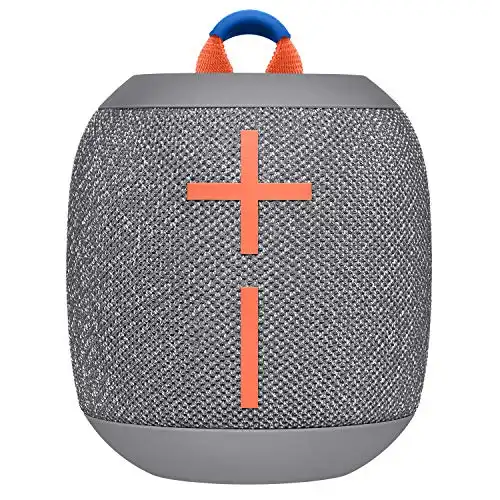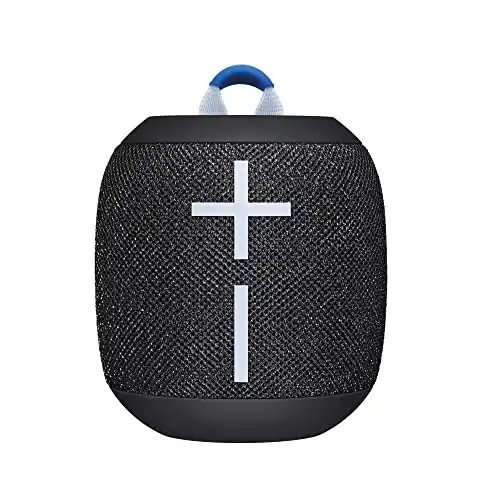After spending 3 years talking about how phenomenal the sub-$100 UE Wonderboom 2 is, we had high hopes for the new-and-improved UE Wonderboom 3.
And honestly, I am quite disappointed after two weeks of testing.
If I had never used the Wonderboom 2, I would test the Wonderboom 3 and declare that it is one of the best sub-$100 speakers on the planet. But the lack of upgrades compared to the Wonderboom 2 make the Wonderboom 3 feel like a letdown.
The design is essentially identical. The new version still lacks a companion app or an equalizer. And despite the 2022 release date, the speaker still features micro-USB charging.
Most importantly, I didn’t hear any difference in sound quality or maximum volume between the two speakers.
Is the UE Wonderboom 3 a great speaker? Yes, especially considering the relatively low price. But it doesn’t improve upon the Wonderboom 2 in any significant way.
|
|
|
|
N/A
|
N/A
|
|
Pros:
|
Pros:
|
|
Cons:
|
Cons:
|
- Incredible soundstage
- Excellent build quality and durability
- Lacking in "smarts" (no app, no EQ, etc.)
- Same high quality of previous version
- Slightly improved battery life
- Cool new features like Android Fast Pairing & recycled plastic materials
- Not much is upgraded from previous generation
~~~ Check Price: UE Wonderboom 3 ~~~
~~~ Check Price: UE Wonderboom 2 ~~~
Sound
As mentioned above, there isn’t much difference in sound quality between the two speakers.
During side-by-side testing, nothing really stood out. Both speakers have punchy bass and a wide, three-dimensional sound that most portable speakers can’t compete with.
Maximum volume was almost identical on the two speakers. And both sounded great at volumes up to 70%, and then started to distort above 80%.
I wouldn’t consider the Wonderboom a “party speaker,” but there is a definite focus on bass over mids. Vocals sound good but not great, and there is a tinny quality to the mids.
By adding a third-party equalizer on your source device, you can improve the sound quality compared to the stock, out-of-the-box profile. But the device lacks a built-in EQ.
Both Wonderboom 2 and Wonderboom 3 have an “Outdoor Boost” mode that is accessed by a tree-shaped button on the underside of the device. This adjusts the sound settings to improve audio in outdoor environments.
The Outdoor Boost change is more subtle than expected, and it mainly serves to increase the bass. Since the sound profile is already more bass-heavy than ideal, I don’t see much benefit in this feature. But for people that are more geared toward a party speaker, this button could be the perfect touch for pool parties and bonfires.
Both versions of the Wonderboom are perfect for anyone seeking immersive audio and a wide soundstage.
Many portable speakers have “dead zones” where the audio sounds poor (or quiet). Usually, these zones occur when you are standing behind the speaker, or at a diagonal to the speaker, or if the speaker has a higher or lower elevation than your ears. With the Wonderboom, there really aren’t any dead zones — instead, the speaker sounds similar from almost any position in the room.
Sound winner: Tie (even during side-by-side testing, I didn’t hear any noteworthy differences)
Design
Observant readers will notice a common theme in each section — the lack of any significant changes between the Wonderboom 2 and the Wonderboom 3.
The good news is that Ultimate Ears didn’t make any harmful changes with the new version. We completely support this, since the Wonderboom 2 is an excellent speaker. The bad news is that we waited three years for an upgrade, and the Wonderboom 3 feels more like an identical speaker than an actual upgrade.
The design of the two speakers is nearly identical. The only difference is that the Wonderboom 3 has a more eco-friendly design, using 31% recycled plastic. The fabric speaker cover also has a slightly changed feel, with the new version having a rougher, more course feel.
Both speakers are the same dimensions and weight. The controls are identical, as well.
The speakers are actually so similar that the only way to definitively tell them apart is to check the bottom of the device to see whether the text says “Wonderboom 2” or “Wonderboom 3.”
While we aren’t as upset about this feature as some other tech reviewers, the micro-USB charging is an odd design feature. In the 3+ years since the release of the Wonderboom 2, USB-C charging has become an industry standard in portable speakers. Most of us had assumed that the Wonderboom 3 would get this obvious upgrade.
Design winner: Tie (both products feature an excellent design; however, other than the recycled plastic, there isn’t any improvement or change in the design)
Durability
Both speakers rate well for durability.
Each product has an IP67 (waterproof and dustproof for casual use) rating. And to increase the waterproofing further, the speakers also float.
UE also rates the products for drop resistance. Company testing has shown that the speakers can withstand drops up to 5 feet. User testing has also shown that the Wonderboom can withstand drops in excess of 5 feet.
Wonderboom 2 and 3 both have two year warranties. This is somewhat unexpected from a portable speaker, since most competing products offer 1 year or less. As if that isn’t enough, the speakers are also well-built and durable — so it wouldn’t be surprising if these products significantly outlast the warranty.
The speakers are made by Logitech and are produced in China.
In the sub-$100 price range, it is hard to beat the durability of either Wonderboom.
Durability winner: Tie (other than the recycled plastic, there aren’t any changes; I wouldn’t expect the recycled plastic to impact durability for the better or worse)
Battery
Neither Wonderboom version discloses specifics about the size of the battery. However, the Wonderboom 2 is rated for 13 hours of use, while Wonderboom 3 improves on this slightly with a 14 hour rating.
My guess is that the battery is the same, and the additional 1 hour of battery life comes from an upgraded bluetooth version. Newer bluetooth versions tend to be more battery-friendly, so I would assume that is how UE plans on gaining an extra hour of function.
However, the above assumption is tough to confirm since Ultimate Ears doesn’t like publishing information about battery size or bluetooth version.
During testing, there wasn’t any noticeable difference in battery life. Having said that, the only way to be sure would be testing the products side-by-side for 14 hours with the exact same audio at the exact same volume. In full disclosure, I didn’t test it that closely — and I don’t intend to.
Both speakers get 12+ hours at 50% volume. So we give UE points for (almost) living up to their battery life promises.
Neither speaker has a power bank for charging a phone. And, as stated above, both use micro USB charging.
The only visible indication of battery life occurs when the small LED on top of the speaker turns red with low battery.
There isn’t a status bar, and there is no app to check on battery life either. If you hold the “Volume +” and “Volume -” buttons at the same time, the speaker makes a sound that indicates whether the battery is High, Medium, or Low. But the sounds weren’t very distinctive, so it was hard to tell what the sound actually meant.
Battery winner: Wonderboom 3 (but the difference is pretty miniscule)
Software
We were hoping for a companion app with the Wonderboom 3. No such luck…
Both speakers lack an app, and thus also lack a party mode.
Wonderboom 2 is able to wirelessly pair with another Wonderboom or Wonderboom 2. Wonderboom 3, on the other hand, can only pair with another Wonderboom 3. So, there isn’t any way to connect a Wonderboom 2 and 3 together.
The only real improvement with Wonderboom 3 is the Fast Pair feature. And honestly, this feature is pretty cool for those of us that use an Android device.
Typically, you have to access your device’s settings in order to pair a new speaker. This isn’t much work, but sometimes it can be challenging to pair a new device, especially for those of us that aren’t tech-savvy.
Rather than having to manually pair the speaker at start-up, the Wonderboom 3 basically automates the process.
As soon as I powered the speaker on, I got a pop-up on my phone with a picture of the Wonderboom 3. Underneath the picture was a blue “Connect” button. Just click the button, wait a few seconds, and your phone and speaker are paired.
Again, this Fast Pairing only works with Android devices — so anyone with an iPhone will still have to manually pair the speaker.
Neither speaker has an equalizer, but it is fairly simple to download a third-party equalizer on your source device. Both products also lack WiFi, a mic, a power bank, and every other premium feature. These aren’t feature-rich speakers, but they function easily and function well.
Although bluetooth versions aren’t disclosed by UE, the Wonderboom 3 promises additional bluetooth range (130 feet vs. 100 feet). During testing, there weren’t any observable distances.
Both speakers have a power on/off noise which is somewhat annoying. During testing, I never figured out whether this could be muted. It isn’t anything worth worrying about, but it is noteworthy because it could drive some people crazy.
Software winner: Wonderboom 3 (Fast Pairing is great for Android users, and the bluetooth version seems to have been updated, which also slightly improves battery life)
Performance in Various Environments
While sound quality is often tested in ideal conditions, it’s important to consider how the Wonderboom speakers perform in various real-world environments. From outdoor picnics to house parties and quiet indoor sessions, the use of these portable speakers isn’t limited to just one setting.
In outdoor settings, both the Wonderboom 2 and 3 provide solid performance with their 360-degree sound design, enabling them to fill a relatively large area with sound. The “Outdoor Boost” mode adds a little extra bass, which can be useful when there is a lot of ambient noise. Despite the tinny quality to the mids, both versions of the speakers produce an acceptable sound for a fun day at the beach or a backyard barbecue.
Indoors, the performance is rather impressive. In smaller rooms, the speakers can easily fill the space with high-quality sound, providing an immersive audio experience. The wide soundstage these speakers offer also means that you’ll get good sound no matter where you place the speaker in the room.
In crowded environments like house parties, the speakers hold up reasonably well, but don’t expect them to compete with larger, more powerful sound systems. They’re loud enough to be heard over a crowd, but the sound can become distorted at higher volumes. It’s important to remember that these are still compact, portable speakers and their performance should be evaluated with that context in mind.
In quiet settings where details matter, the Wonderboom speakers perform reasonably well. You’ll be able to enjoy a variety of genres, but keep in mind that the speakers have a notable focus on bass. If you’re someone who values balanced sound or loves vocal-heavy music, you might find the sound quality lacking.
Final thoughts
Wonderboom 2 and Wonderboom 3 are both excellent speakers, especially considering the sub-$100 price tag.
However, the Wonderboom 3 provided disappointingly few updates over the previous version. We would have loved to see an added EQ, upgraded USB-C charging, or a companion app. Even if those features weren’t realistic, it would have at least been nice to get a significant sound quality or battery life improvement.
|
|
|
|
N/A
|
N/A
|
|
Pros:
|
Pros:
|
|
Cons:
|
Cons:
|
- Incredible soundstage
- Excellent build quality and durability
- Lacking in "smarts" (no app, no EQ, etc.)
- Same high quality of previous version
- Slightly improved battery life
- Cool new features like Android Fast Pairing & recycled plastic materials
- Not much is upgraded from previous generation
My strong advice is to keep an eye out for discounts on the UE Wonderboom 2. For all intents and purposes, it can do everything that the Wonderboom 3 can. But with the new version released, it is likely that there are some good sales coming on the older version.
If Fast Pairing, a slight battery improvement, and an emphasis on recycled plastic matters to you, the Wonderboom 3 is still worth every penny of its sub-$100 purchase price. But otherwise, save the money and choose the Wonderboom 2.
~~~ Check Price: UE Wonderboom 3 ~~~
~~~ Check Price: UE Wonderboom 2 ~~~
FAQs
Does the Wonderboom 3 sound better than Wonderboom 2?
There doesn’t seem to be a noticeable difference in sound quality between the two speakers, even in side-by-side testing.
What are the improvements in Wonderboom 3 over Wonderboom 2?
The Wonderboom 3 offers Fast Pairing for Android devices, a slightly improved battery life, and a more eco-friendly design with 31% recycled plastic. The sound quality, however, remains identical to its predecessor.
Is it possible to pair a Wonderboom 2 with a Wonderboom 3?
Unfortunately, no. The Wonderboom 3 can only pair with another Wonderboom 3, while the Wonderboom 2 can pair with another Wonderboom 2 or another Wonderboom.





